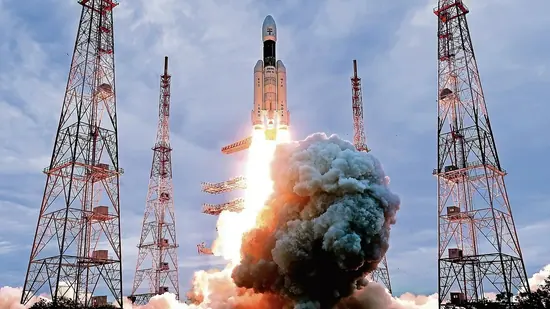As a follow-up mission to Chandrayaan-1 in 2008 and Chandrayaan-2 in 2019, the Indian Space Research Organisation (ISRO) launched its third lunar mission, Chandrayaan-3, from the Satish Dhawan Space Center (SDSC) in Sriharikota on July 14, 2023, at 2:35 pm.
On October 22, 2008, India successfully launched its first mission to the Moon, Chandrayaan-1, from Satish Dhawan Space Centre in Sriharikota. The spacecraft orbited the Moon 100 km above its surface, performing chemical, mineralogical, and photographic mapping of the Moon. The mission required 11 scientific instruments built by India, the USA, the UK, Germany, Sweden, and Bulgaria. Chandrayaan-1 made over 3400 orbits around the Moon and discovered water and hydroxyls on the surface. Unfortunately, communication with the spacecraft was lost on August 29, 2009, marking the end of the exploration.
The Chandrayaan-2 mission was a mission that marked a significant technological advancement from the previous mission conducted by ISRO. It involved an orbiter, lander, and rover to explore the unexplored South Pole of the Moon. The objective was to expand knowledge of the Moon through detailed studies of its topography, seismography, mineral identification and distribution, surface chemical composition, thermo-physical characteristics of topsoil, and composition of its atmosphere.
However, while orbiting the Moon in a 100 km polar orbit, on September 02, 2019, the Vikram lander separated from the orbiter in preparation for landing. Vikram performed de-orbit maneuvers and began circling the Moon. Its descent was normal until an altitude of 2.1 km. Afterward, communication from the lander to the ground stations was lost.
The orbiter, placed in its intended orbit around the Moon, collected information regarding its evolution and mapping of the minerals and water molecules in polar regions. Its camera provides high-resolution images for the global scientific community. The precise launch and mission management ensured a long life of almost seven years instead of the planned one year.
Chandrayaan-1 was an orbital mapping mission, while Chandrayaan-2 was an attempt at the soft landing of a rover on the Moon for exploration. Chandrayaan-3 is the ISRO’s second attempt at landing a rover on the Moon. Most of the time, agencies will deploy rovers and payloads on the equatorial region of the Moon due to its favorable landing conditions, brighter environments, higher temperatures, and uninterrupted communication with the ground team, but Chandrayaan-3 aims to land on the vastly different lunar south pole. The mission contains a variety of payloads to deploy:
The Chandrayaan-3 mission has had other changes and improvements from its precursor, including a larger landing area, more fuel, more solar panels, and more navigational instruments. The ISRO utilized the high-quality images acquired from the unsuccessful Chandrayaan-2 mission to pinpoint the landing area for the lander.
The journey will last about 42 days, with the expected landing scheduled for August 23, 2023. The lander and the rover will have a mission life of 14 days or one lunar day.
Works Cited
“Chandrayaan-3.” Drishti IAS, 17 July 2023, www.drishtiias.com/daily-updates/daily-news-analysis/chandrayaan-3-2#:~:text=These%20payloads%20include%20studying%20lunar. Accessed 5 Aug. 2023.
“Chandrayaan-3.” Www.isro.gov.in, www.isro.gov.in/Chandrayaan3_New.html.
Jaiswal, Bhavesh, et al. “Spectro-Polarimetry of Planetary Atmospheres: Radiative Transfer Simulations and Instrument Concept.” NASA ADS, vol. 42, July 2018, pp. C3.1-3118, ui.adsabs.harvard.edu/abs/2018cosp…42E1587J/abstract. Accessed 5 Aug. 2023.
“LIBS, Laser Induced Breakdown Spectroscopy, Thermo Fisher – US.” Www.thermofisher.com, www.thermofisher.com/us/en/home/industrial/spectroscopy-elemental-isotope-analysis/portable-analysis-material-id/industrial-elemental-radiation-solutions/how-does-libs-work.html#:~:text=LIBS%20is%20an%20acronym%20for. Accessed 5 Aug. 2023.
mars.nasa.gov. “APXS | Instruments – NASA’s Mars Exploration Program.” NASA’s Mars Exploration Program , 2019, mars.nasa.gov/msl/spacecraft/instruments/apxs/.
Williams, David. “NASA – NSSDCA – Experiment – Details.” Nssdc.gsfc.nasa.gov, 28 Oct. 2022, nssdc.gsfc.nasa.gov/nmc/experiment/display.action?id=CHANDRYN3-01. Accessed 5 Aug. 2023.












